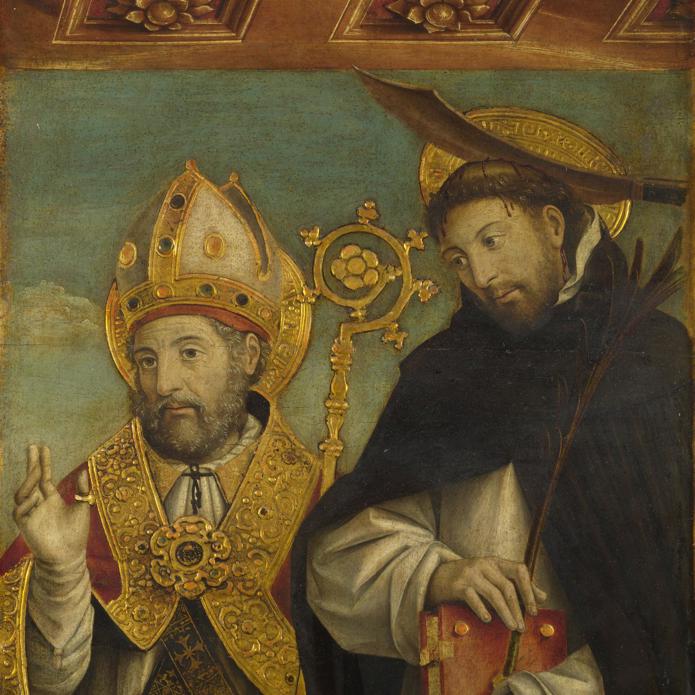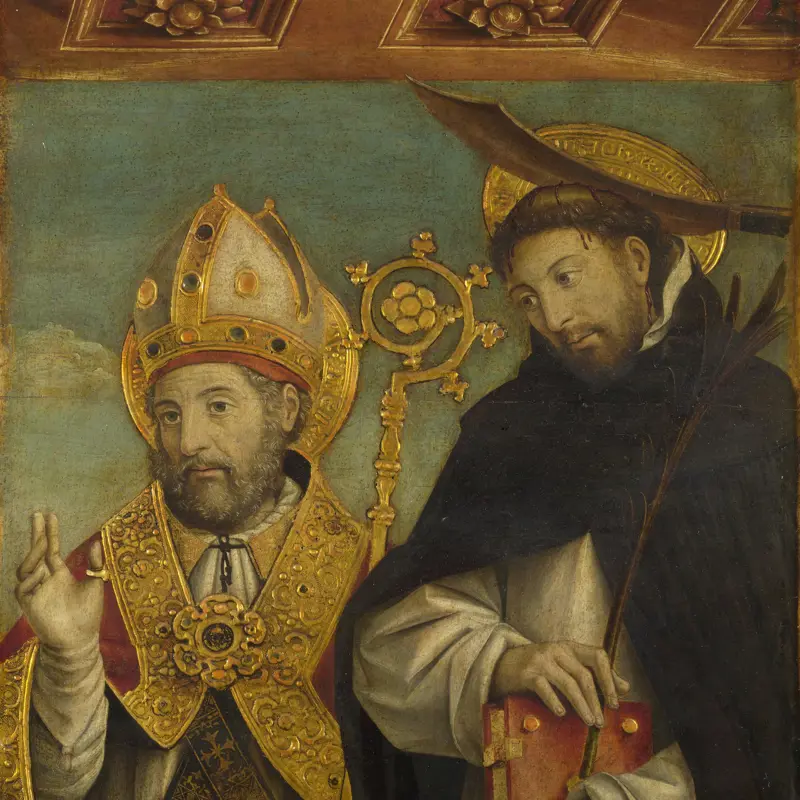Giovanni Martino Spanzotti, 'Saints Nicholas of Tolentino and John the Baptist', 1496-1500
About the work
Overview
This and Saint Peter Martyr and a Bishop Saint are panels from the upper tier of the Dal Ponte Altarpiece. The altarpiece was dedicated to Saint Andrew, who featured in the central panel, and it was made for the church of San Francesco in Casale Monferrato. The other panels are in the Albertina, Turin; the Brera, Milan; and a private collection.
Saint Nicholas of Tolentino was a thirteenth-century Augustinian friar who ministered to the poor and criminals, and built a reputation as a miracle worker. He has a radiance in the centre of his chest and gazes at a crucifix. The quotation in his book is from the Gospel of John, 15: 10: PRECEPTA PATRIS MEI SERVAVI (‘I have kept my father’s commands’). Saint John the Baptist can be recognised by his traditional robe of camel skin and his scroll marked: ECCE AGNVS DEI QVI TOLLIT [PECCATA MUNDI] (‘Behold the lamb of God who takes away the sins of the world.’)
Key facts
Details
- Full title
- Saints Nicholas of Tolentino and John the Baptist
- Artist
- Giovanni Martino Spanzotti
- Artist dates
- active 1480 to about 1523
- Part of the series
- The Dal Ponte Polyptych
- Date made
- 1496-1500
- Medium and support
- oil on wood
- Dimensions
- 76.2 × 52.1 cm
- Acquisition credit
- Bought, 1885
- Inventory number
- NG1201
- Location
- Not on display
- Collection
- Main Collection
Provenance
Additional information
Text extracted from the ‘Provenance’ section of the catalogue entry in Martin Davies, ‘National Gallery Catalogues: The Earlier Italian Schools’, London 1986; for further information, see the full catalogue entry.
Bibliography
-
1951Davies, Martin, National Gallery Catalogues: The Earlier Italian Schools, London 1951
-
1986Davies, Martin, National Gallery Catalogues: The Earlier Italian Schools, revised edn, London 1986
-
2001
C. Baker and T. Henry, The National Gallery: Complete Illustrated Catalogue, London 2001
About this record
If you know more about this work or have spotted an error, please contact us. Please note that exhibition histories are listed from 2009 onwards. Bibliographies may not be complete; more comprehensive information is available in the National Gallery Library.
Images
About the series: The Dal Ponte Polyptych
Overview
Saints Nicholas of Tolentino and John the Baptist and Saint Peter Martyr and a Bishop Saint, both in the National Gallery’s collection, are panels from the Dal Ponte Altarpiece. It was a multi-part altarpiece and we can tell that these panels would have formed part of the upper tier because the vaulted ceiling is painted as though viewed from below. The third panel of the upper tier is in a private collection.
The altarpiece, made for the church of San Francesco in Casale Monferrato, was dedicated to Saint Andrew and he was depicted in the main panel (Brera, Milan). Saint Francis and Saint Agatha with Kneeling Donor (Accademia Albertina, Turin) was on the left of the main panel and Saints Catherine and Sebastian (Brera, Milan) was on the right. The meticulously painted luxury, humanity and sense of space in these panels show the influence of Francesco Cossa, with whom Spanzotti had worked as a young man, as well as Flemish, Burgundian and Milanese painting.



